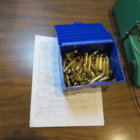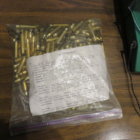Storing brass and keeping track of how many times it has been fired isn't rocket science. You can use almost any kind of container you like; I prefer plastic food storage containers. They're inexpensive, they come in a wide range of sizes, and they're stackable. The image below is brass storage for one of my .308s.
1) The brass in the container on the left is ready to load. Note that some of it has already been sorted into specific weight groups, which go into labeled Ziplock bags within the food container for that specific brass prep/Lot#. The piece of masking tape with writing in black Sharpie on the box lid contains the date the brass prep was finished (i.e. "Ready to Load"), the specific rifle it is for, the specific Lot#, and the number of firings it has undergone.
2) The brass in the container on the right has been fired and decapped. Each time I reload a batch of ammo using that brass, the lid of the ammo box gets labeled with another piece of masking tape that contains the date, the specific rifle it is for, the Brass Prep # and the number of times it has been fired (which are always one number higher than those two numbers on the "ready to Load" container the brass came from), the Lot#, and a brief description of the loaded ammo. That way, I can always find all the specific information and details about that batch of ammo recorded in my reloading book for that specific rifle. After the ammo has been fired and decapped, the cases go into the "fired" brass container, and the label from the top of the ammo box goes on the lid of the fired brass container. That way, I always know exactly what brass is in it (i.e. how many firings, how many pieces, etc.).
When all of a specific brass prep has been fired and the decapped brass transferred to the 2nd container, I can start another brass prep whenever I feel like it. Within reason, I typically try to carry out a single step on all of the brass in a given Prep# before moving on to the next step. In other words, all pieces of brass get cleaned before primer pockets are checked; all primer pockets are checked before any cases are annealed, all cases are annealed before any are re-sized, etc. As each step in the process is completed, I add that to the label>>>i.e. decapped, cleaned, primer pockets uniformed, annealed, etc. That way I always know exactly what step of the process the brass is on by a quick glance at the label, because I generally complete a full prep of 300+ pieces over two to three days.
As I noted, this stuff isn't rocket science. There are a variety of methods that will work equally well, as long as you can write down a suitably descriptive label and date so you know what's in it. The labels I described for the brass containers, as well as the ones that get switched over from the ammo boxes once the loaded rounds have been fired literally take a minute (or less) to fill out. There's no good reason for not properly labeling brass containers so that you exactly what is in it, what rifle it's for, how many times it's been fired, and when it was prepped. Even if you're starting with mixed-Lot# brass from commercial ammunition, you can easily keep track of it in terms of the number of firings as though it all came from a single Lot#.
As mentioned, I like the food containers because they're dirt cheap and come in various sizes suitable for a wide range of different cartridges and/or quantities of brass. I typically use the small rectangular ones that are about 3"x4"x6" for 100 0.223 Rem cases. The ones that are about sandwich size hold a few more, so on and so forth, up to the containers shown in the image that are approximately 3"x10"x14", which will hold up to ~500 .308 cases. I like to prep
at least 300 pcs of brass for each of my competition rifles, so I don't have to prep brass every single time I shoot. I'd much rather prep a batch of 300 or 400 cases all at once every few months or so, than prep 75 cases every single time I shoot a given rifle. But that's just me; either way will work. The key is to label what you have fanatically - that way you always know what it is. Over time, the process of labeling becomes second nature so you don't even think about it any longer, and you never end up looking at a box of spent brass think, "Hmmm...I wonder what this stuff is?"
















